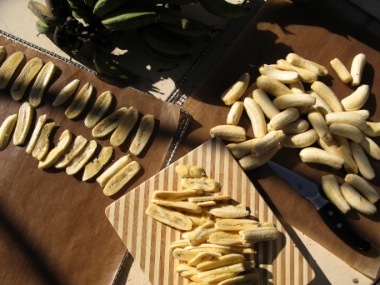
If you like the taste of onion seed bagels but want to avoid the wheat, calories and baking that a traditional bagel brings, try these fabulous onion flatbreads.
There are two recipes today that use sunflower seeds, so the first thing to do is get about 3 cups of sunflower seeds soaking. Some chefs only soak seeds for an hour or so, but I like to sprout the seeds, so they soak overnight, I rinse them and let them grow for a day, then make these breads. Don't forget to put flax seeds on to soak.
Have I introduced you to Golubka's blog yet? I found these delicious flatbreads here.
I make these breads in a high speed blender instead of a food processor. It really doesn't matter, except for how you process the flax seeds.
2 medium onions, cut into large pieces for the blender to handle.
1 cup of sprouted sunflower seeds (you will use more later on the top of the flatbreads)
4 tablespoons tamari or nama shoyu
4 tablespoons olive oil
1 cup flax seeds BUT if you are making them in a high speed blender and have soaked the flax seeds first, you will have what looks like a little flax cake. Once you have blended the other ingredients, cut the flax into strips that will drop through the feed hole in the top of your blender. With the blender on high speed, gradually feed in the strips until they are blended to the consistency you like (some like to have some whole flax seeds in the bread, some don't). If you don't have a high speed blender.....don't do this!!!! Your blender will choke and die quite quickly. If a Vitamix overheats, it simply stops until it cools down (or you put it in the freezer for awhile). If a regular blender becomes overburdened, the motor can quickly burn out.
If you are making these in a food processor, pre-grind the seeds in a coffee grinder or dedicated seed grinder and add them after you have processed the other ingredients. If you are using a regular blender, you have cut the onions smaller, for sure, and you can put the blended mixture into a bowl where you have already placed the flax seeds. Be ready to stir like crazy before it clumps.
(I know I said all this in part 1 but I don't want to feel responsible for your fried blender or sad, lumpy flatbread).
It's all good. This is not brain surgery or rocket science.
Place teflex sheets on your drier shelves and spread the mixture out. Now for the fun part....find every delicious kind of seed you have in your pantry or garden and you are ready to create the topping. I found fennel and parsley seeds in the garden and poppy, hemp, sesame in the pantry. I corse ground some coriander on top and sprinkled the rest, with lots of the sprouted sunflower seeds. Chop parsley leaves and sprinkle. Golubka has a wonderful tip for the next step. Wet your hands and press the seeds and leaves into the mixture. (I used to have problems with the seeds falling off in the dehydrator or when cutting, but no more. Wet hand patting really embeds the seeds into the mixture.)
That's it!

Dehydrate at 105 degrees until they are ready to come off the teflex sheets. Turn them over, remove the sheets, dehydrate some more until they can be cut with a knife, scissors or a pizza wheel. Dehydrate a little more to dry the edges. If you want them really crispy, dehydrate longer. For a bread, leave the pieces bigger. Great for bruschettas. Crispy, they are fabulous with new cashew cheese.
I said there would be another recipe today but I'm out of time. Put those extra soaked seeds in the refrigerator until tomorrow. They will be fine.


























































